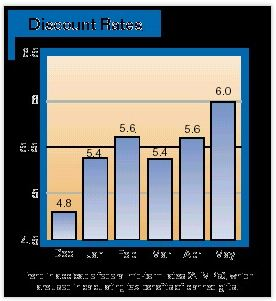Over the years, many donors have enjoyed the satisfaction of establishing a gift annuity or charitable remainder trust with highly appreciated, low-yielding securities. More often than not, publicly traded stocks, real estate, and/or cash have been used to fund such gifts.
Today’s economic environment can still be very attractive for life income gifts and may also favor another funding source—appreciated corporate and government bonds.
Taking bonds into account
In periods of stable interest rates, bond prices tend to be stable as well. However, as interest rates rise and fall, bond values can also be expected to fluctuate in a countercyclical fashion. As interest rates fall, the value of a bond goes up. Similarly, as rates increase, the value of a bond goes down, assuming other factors that bear on valuation remain the same.
Some trustees learned this lesson the hard way with net income variations of the charitable remainder unitrust that were, unfortunately, sometimes heavily invested in bonds in the late 1970s and 1980s. As interest rates rose to record levels, the market price of those bonds plummeted far below face value. Income beneficiaries then saw the amount of their unitrust payments decline, even though their trusts continued to receive the same level of bond income.
For example, if a 5% net income unitrust were invested in high quality bonds yielding 6%, the trust would appear to have no problem making the required 5% payment each year. In fact, the trust would potentially grow each year as a result of the excess interest being added to the trust corpus. If, on the other hand, interest rates rose to 12%, the market value of the bonds could be expected to fall by approximately 50%. If the trust were initially valued at $1 million, the annual payment would be $50,000 (5% of $1 million). If the market value of the bond portfolio fell to $500,000, the payments would fall to $25,000 (5% of $500,000) even though the bonds still generated $60,000 in interest that year. In this case, income would essentially be “trapped” inside the trust.
Conversely, another problem can occur if interest rates fall dramatically and the value of the bond portfolio increases in value. If the trust were a straight payment unitrust, the payee would be required to distribute not only the income but also a portion of the principal each year with potentially negative impact on future performance of the trust. In the example above, suppose the prevailing interest rates fell to 3% and the value of the bonds doubled to $2 million. The unitrust payment would then be $100,000 (5% of $2 million) while the interest income would still be $60,000, necessitating a $40,000 encroachment on the gain in the value of the trust principal.
Because of the havoc bond fluctuations can potentially wreak on unitrust payments, in recent years there has been a trend toward investing charitable remainder trust assets in portfolios more balanced between debt, equity, and cash designed to produce more stable total returns over time and “flattening” distributions accordingly.
During the 2001-2002 period we have seen interest rates of all types fall dramatically. The Federal Reserve Bank has cut interest rates charged to banks 11 times in an attempt to keep the economy from falling into an extended recession.
Many believe it is unlikely, however, that interest rates will fall much further. Indeed, history tells us it is more likely that interest rates will gradually rise over time. Based upon these circumstances, persons that have invested heavily in bonds for income are facing a dilemma.
It may be difficult to reinvest the short-term bonds that are currently maturing to earn the same level of interest. Medium- and long-term bonds may have increased in value but pay no more income than they did originally. As a result, even though a donor’s net worth may have increased, his or her spendable income may be flat or decreasing.
What to do?

One strategy to increase income, generate current tax deductions, achieve tax-free diversification, and make a charitable gift would be to select the most highly appreciated long- and mid-term bonds and use them to fund a charitable gift annuity, charitable remainder annuity trust, or unitrust.
With proper planning, it should be possible for donors with highly appreciated bond portfolios to “give out of the market” on a very advantageous basis. By using such investments to fund a gift annuity or charitable trust it is possible to lock in the appreciated value of these securities, avoid capital gains tax that would be due on the sale of the bonds, and receive very attractive rates of return based on the full value of the assets. As a bonus, a significant portion of the payments from the gift plans may be taxed at favorable capital gains rates, instead of higher ordinary income tax rates. A donor will also receive a significant income tax deduction for the charitable gift element, which may provide income tax savings in the year of the gift and for up to five additional years.
If interest rates have indeed bottomed out, now may be an ideal time to achieve the maximum benefits for donors by using bonds that are not normally thought of as “capital gain property” to fund life income gift plans.

